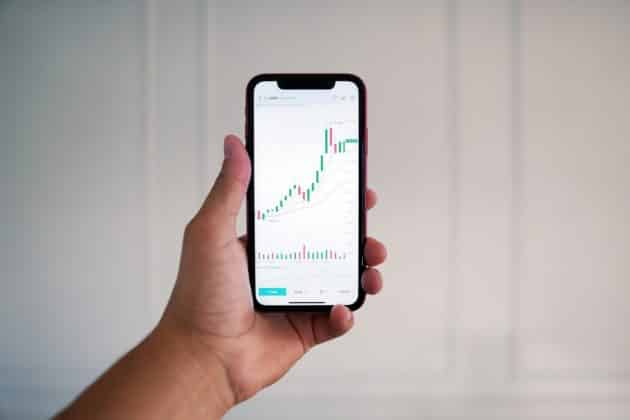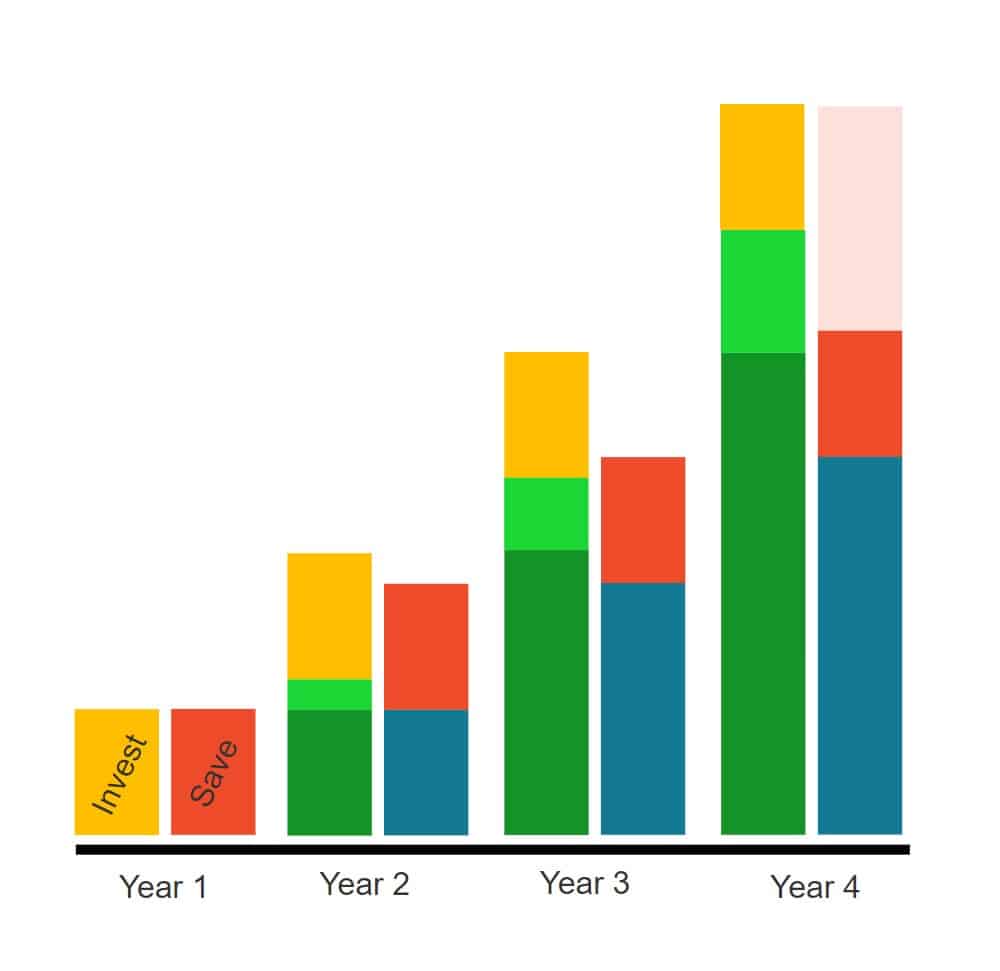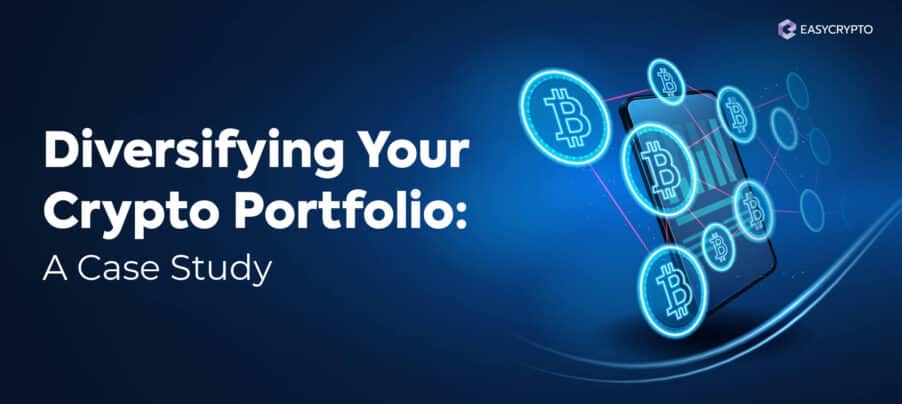Benefits of Investing Vs. Saving: A Closer Look at the Math
Learn the importance of investing, how it works, the benefits, and how it can save you both time and money compared to saving.


Having more money than you need to live comfortably every day is indeed a privilege. If you have gotten into the habit of saving your excess income, then you’re already miles ahead of those who are still figuring out how to manage their finances.
You may also have learned that investing a portion of your excess income is a great way to grow your wealth passively. After all, investing isn’t just about making money work for you. It’s also about saving time from saving up for too long.
It can be difficult to believe this at first – how can routinely buying assets help you not only to preserve your hard-earned income but also potentially earn you a bit of extra income in the long term?
How can doing “no work” produce this extra money? Where does this money come from?
In this article, we’ll be taking a closer look at how investing can save you time and money in the long run. Of course, and I’d like to remind our readers that this is not to be taken as financial advice and serves only as educational purposes.
How does investing grow your money?
Money doesn’t come from trees, but they certainly can grow like one. It’s all thanks to the wonderful effect of compounding interest. But how can the value of an asset compound over time? It seems too good to be true that an asset that we leave alone can grow in value exponentially.
The fact is, it’s not too good to be true — it’s just the natural consequence of a growing market and a consistent surplus of buyers. Plus, humans aren’t good at thinking in terms of percentages, like percent increase or decrease.
An example of this will be extremely useful. Let’s say you’re planning to buy gold every year for a consistent cost of $1000.
Gold is a great example of an asset that is deflationary against money. Let’s say you buy unit A in 2021, unit B in 2022, unit C in 2023 and so on.
As five years pass, unit A appreciates by 8% in 2022, 5% in 2023, 10% in 2024, 9% in 2025, and 8% in 2026. Unit B appreciates all these percentages except for the first 8%. Units C, D, and E all appreciate in succession, with unit E only having to appreciate 8% in the final year.
How much is your net worth in gold? It’s certainly more than $5000. If we verify mathematically:
A + B + C + D +E
= ($1000 x 108% x 105% x 110% x 109% x 108%) + ($1000 x 108% x 105% x 110% x 109%) + ($1000 x 108% x 105% x 110%) + ($1000 x 108% x 105%) + ($1000 x 108%)
= $6289.50
There is no mind trick here. In an up-trending market – the current value of an asset is a percentage increase in all the percentage increases that have ever happened in the past.
Here’s a visual way to think about it (not to scale):

Although the amount that we invest (dark yellow) is consistent, the net worth invested (dark green) will compound — increasing by percentage after percentage. The light green bars represent value-added from appreciation of the net value invested in the previous year.
The light red bar represents the difference between the saver’s and the investor’s portfolio.
Saving saves money, investing saves time and money
Rarely do we factor in time when we talk about saving. That’s because saving is a straightforward arithmetic operation. Save $1000 a year, and in 10 years, we’d have at most $10,000.
But now, if we consider time, things will get a lot more interesting, especially in investing. Take a look again at the above bar chart. This chart was made so that the investor’s assets grow by 25% per year. This means, in the fourth year, the saver must save around 3 years’ worth of savings in order to catch up to the investor’s portfolio value.
Of course, the investor would invest for 3 more years, and the saver will probably never catch up to them. Now, 25% annual percentage yield (APY) is an ambitious number.
To put things into perspective, a gold investor could get away with 5-50% APY while a stock investor typically gets 5-25% APY (this still depends on the country).
Is 5% yield per year enough to beat saving money in a savings account? Well, take a look at the table below to see for yourself.
This is a simulation that assumes the following:
- Both the saver and investor deposit the same amount every year — $1200.
- Value appreciation is consistent at an average of 5% for the investor and 0.5% for the saver.
- Inflation is negligible.
| Year | Net worth in invested assets | Net worth in saved cash | Difference | In years worth of savings |
| 1 | 1260.00 | 1206.00 | 54.00 | 0.0 |
| 2 | 2583.00 | 2418.03 | 164.97 | 0.1 |
| 3 | 3972.15 | 3636.12 | 336.03 | 0.3 |
| 4 | 5430.76 | 4860.30 | 570.46 | 0.5 |
| 5 | 6962.30 | 6090.60 | 871.69 | 0.7 |
| 6 | 8570.41 | 7327.06 | 1243.35 | 1.0 |
| 7 | 10258.93 | 8569.69 | 1689.24 | 1.4 |
| 8 | 12031.88 | 9818.54 | 2213.34 | 1.8 |
| 9 | 13893.47 | 11073.63 | 2819.84 | 2.3 |
| 10 | 15848.14 | 12335.00 | 3513.14 | 2.9 |
| 11 | 17900.55 | 13602.67 | 4297.88 | 3.6 |
| 12 | 20055.58 | 14876.69 | 5178.89 | 4.3 |
| 13 | 22318.36 | 16157.07 | 6161.29 | 5.1 |
| 14 | 24694.28 | 17443.86 | 7250.42 | 6.0 |
| 15 | 27188.99 | 18737.08 | 8451.91 | 7.0 |
| 16 | 29808.44 | 20036.76 | 9771.68 | 8.1 |
| 17 | 32558.86 | 21342.95 | 11215.92 | 9.3 |
| 18 | 35446.80 | 22655.66 | 12791.14 | 10.7 |
| 19 | 38479.14 | 23974.94 | 14504.21 | 12.1 |
| 20 | 41663.10 | 25300.81 | 16362.29 | 13.6 |
| 21 | 45006.26 | 26633.32 | 18372.94 | 15.3 |
| 22 | 48516.57 | 27972.48 | 20544.09 | 17.1 |
| 23 | 52202.40 | 29318.35 | 22884.05 | 19.1 |
| 24 | 56072.52 | 30670.94 | 25401.58 | 21.2 |
| 25 | 60136.14 | 32030.29 | 28105.85 | 23.4 |
| 26 | 64402.95 | 33396.44 | 31006.51 | 25.8 |
| 27 | 68883.10 | 34769.43 | 34113.67 | 28.4 |
| 28 | 73587.25 | 36149.27 | 37437.98 | 31.2 |
| 29 | 78526.62 | 37536.02 | 40990.60 | 34.2 |
| 30 | 83712.95 | 38929.70 | 44783.25 | 37.3 |
In the first few years, the differences between the portfolio value of the investor and the saver account seem insignificant. But this difference quickly becomes apparent, and the amount of time for the saver to catch up to the investor grows exponentially.
Basically, this is what happens:
- By the sixth year, the value of invested assets is bigger by one year’s worth of savings.
- By the ninth year, we need two year’s worth of savings to match the value of the investment.
- By the 14th and 15th year, we need six and seven year’s worth of savings to catch up.
- By the 28th year, we’d have made double the amount that we saved in the past 30 years.
You take risks even by saving into your bank account
It’s not correct to think that there is no risk at all in keeping cash in a bank account. Sure, as a customer, you have the right to withdraw your money at will. There is almost no risk of losing a large sum of money by simply depositing cash into your bank account.
However, focusing only on this benefit limits your perspective of risk:
- Have you considered that having access to large amounts of liquid cash could tempt you to spend them, rather than saving them for the long-term?
- Have you considered the invisible costs that reduce your future purchasing power? These are economic inflation, bank administration fees, transfer fees, savings fees, and interest tax?
- Have you considered the opportunity costs of not investing at all, which is a chance to make your money work for you?
How much time and money is saved by investing in gold?
Gold is one of the most conservative commodity assets anyone can invest in. Extrapolating historical data by Macrotrends.net, the average annual price change of gold is 14.24% in the past 10 years (2011 – 2021).
We can simulate this annual percentage yield into our comparison table. How long would it take for someone to catch up to a gold investor’s portfolio value, if that person saves $1200 annually? We must assume that the appreciation rate of gold is 14.24% every year.
Let’s take a look at the interesting data points:
- By the third year, the gold investor has gained an additional year of savings compared to someone who doesn’t invest in anything.
- By the ninth year, it would take 10 years worth of savings for that person to catch up.
- By the 21st year, it would take an entire lifetime for that person to catch up to the same value of a gold investor’s portfolio.
How much money do you need in your lifetime?
This is just something to think about when discussing the concept of money and investments. It’s obviously impossible to answer this question with precise numbers, but somehow, we know how much money is too much and how much is too little.
You now know that even 5-10% average annual percentage yield is enough to outpace the interest rate of checking accounts many times over in a span of twenty years.
The next logical step is to estimate how much money is enough for you to achieve your financial goals. Then, calculate how much money you should invest weekly, monthly, or annually with the smallest growth rate you’re willing to tolerate.
You don’t have to be as precise as a financial analyst. You can even use the above table as an estimate. For example, regardless of the amount invested, investing in an asset with 5% average annual returns will grow your wealth five times as fast in 13 years.
Investing in cryptocurrency will give you even more control
Major cryptocurrencies like Bitcoin and Ethereum have long been resilient for many years since their initial release into the market.
While their well-known volatility is something to be considered for new investors, in the long run, these cryptocurrencies have done nothing but outperform almost all traditional assets in the world.
This is a good thing for even the most conservative investors. Let’s say you’re willing to take a small risk to invest in an asset with 5% yearly return.
You have two choices — use all your investment budget on traditional assets that could return 5% annually or use a small portion of your investment budget on cryptocurrency, which could return the same amount (and possibly more).
Over the past 3 years, Bitcoin’s average annual percentage yield is 514.05% (Dec 2018 – Nov 2021). This is one hundred times more than enough for our conservative investment plan.
If you had put one-hundredth of your investment budget on Bitcoin and put the rest (99%) into a more conservative asset, you could return with more cash today than you initially planned.
Further reading: Learn more about crypto investments.
Take your first small steps and diversify into crypto
The truth is, any type of investment is bound to expose you to some risk. The important thing is that you’re fully aware of what you’re getting into, and have considered very carefully about the amount of money you’re putting into an asset.
This is part of being able to calculate risk. Unfortunately, we can’t say exactly how much money you need to invest and which assets you should invest in. If you’re seeking good investment advice, you can go to a professional financial advisor.
We can still help in other ways. If you have finally decided (after a long thought) that crypto assets are for you, you can begin your crypto journey with us!
We’ll give you guidance on how to keep your assets safe, give you a background on various crypto projects, and provide help wherever we can to ensure that your crypto journey is pleasant.
More on crypto diversification: Learn from our in-depth case study.
Disclaimer: The information and discussions in this article are to be used purely for educational purposes only. It is not to be interpreted as financial advice, please conduct your own research and due diligence before investing.
Share to
Stay curious and informed
Your info will be handled according to our Privacy Policy.
Make sure to follow our Facebook, Twitter, Instagram, and YouTube channel to stay up-to-date with Easy Crypto!
Also, don’t forget to subscribe to our monthly newsletter to have the latest crypto insights, news, and updates delivered to our inbox.
Disclaimer: Information is current as at the date of publication. This is general information only and is not intended to be advice. Crypto is volatile, carries risk and the value can go up and down. Past performance is not an indicator of future returns. Please do your own research.
Last updated July 18, 2024





